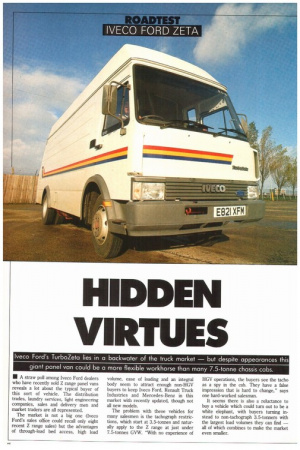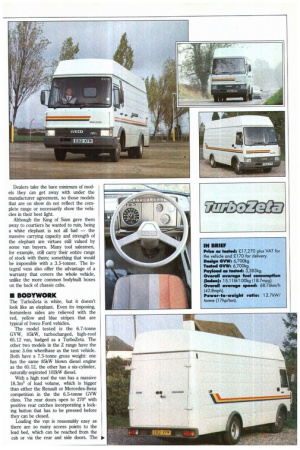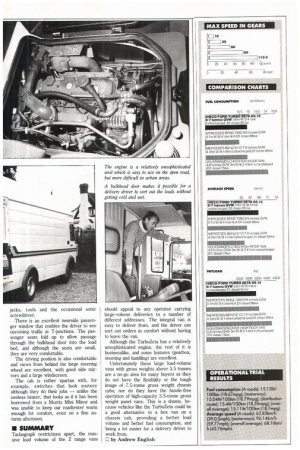HIDDEN VIRTUES
Page 56

Page 57

Page 58

Page 59

If you've noticed an error in this article please click here to report it so we can fix it.
Iveco Ford's TurboZeta lies in a backwater of the truck market — but despite appearances this giant panel van could be a more flexible workhorse than many 7.5-tonne chassis cabs.
. A straw poll among Iveco Ford dealers who have recently sold Z range panel vans reveals a lot about the typical buyer of this sort of vehicle. The distribution trades, laundry services, light engineering companies, sales and delivery men and market traders are all represented.
The market is not a big one (Iveco Ford's sales office could recall only eight recent Z range sales) but the advantages of through-load bed access, high load volume, ease of loading and an integral body seem to attract enough non-HGV buyers to keep Iveco Ford, Renault Truck Industries and Mercedes-Benz in this market with recently updated, though not all new models.
The problem with these vehicles for many salesmen is the tachograph restrictions, which start at 3.5-tonnes and naturally apply to the Z range at just under 7.5-tonnes GVW. "With no experience of HGV operations, the buyers see the tacho as a spy in the cab. They have a false impression that is hard to change," says one hard-worked salesman.
It seems there is also a reluctance to buy a vehicle which could turn out to be a white elephant, with buyers turning instead to non-tachograph 3.5-tonners with the largest load volumes they can find — all of which combines to make the market even smaller. Dealers take the bare minimum of models they can get away with under the manufacturer agreement, so those models that are on show do not reflect the complete range or necessarily show the vehicles in their best light.
Although the King of Siam gave them away to courtiers he wanted to ruin, being a white elephant is not all bad — the massive carrying capacity and strength of the elephant are virtues still valued by some van buyers. Many tool salesmen, for example, still carry their entire range of stock with them; something that would be impossible with a 3.5-tonner. The integral vans also offer the advantage of a warranty that covers the whole vehicle, unlike the more common bodybuilt boxes on the back of chassis cabs.
• BODYWORK
The TurboZeta is white, but it doesn't look like an elephant. Even its imposing, featureless sides are relieved with the red, yellow and blue stripes that are typical of Iveco Ford vehicles.
The model tested is the 6.7-tonne GVW, 85kW, turbocharged, high-roof 65.12 van, badged as a TurboZeta. The other two models in the Z range have the same 3.6m wheelbase as the test vehicle. Both have a 7.5-tonne gross weight: one has the same 85kW blown diesel engine as the 65.12, the other has a six-cylinder, naturally-aspirated 102kW diesel, With a high roof the van has a massive 18.3m3 of load volume, which is bigger than either the Renault or Mercedes-Benz competition in the the 6.5-tonne GVW class. The rear doors open to 270° with positive rear catches incorporating a locking button that has to be pressed before they can be closed.
Loading the van is reasonably easy as there are so many access points to the load bed, which can be reached from the cab or via the rear and side doors. The main problem is the height of the load bed: 0.63m when loaded and 0.89m when unladen. Hauling heavy weights to almost waist height can be very tiring, especially when there are over 3.3 tonnes of them.
Unlike the Mercedes 709D tested last year (CM 6 September 1986) the Zeta has door catches which are sturdy items while the rear, side and passenger doors have handles that look as though they will last at least twice the life of the rest of the vehicle.
The only major gripe we have with the load space is the lack of tie-down eyes. This is especially concerning given the typical buyers of the vehicle. Although tool salesmen are likely to have the whole of the interior racked out, a small engineering company is unlikely to do so. There is a single skin on the interior of the body, and small heavy items are likely to leave their marks on the exterior if they are not tied down.
• DRIVELINE
The van's power unit is a four-litre turbocharged diesel. The injection system uses a Bosch high-pressure rotary fuel injection pump.
Access to the engine for daily checks is limited as the cab doesn't tilt: the header tank is reached from a hatch on the nearside of the van and the oil dip stick is accessible via the hinged front grille, but the oil filler is under the passenger seat, which is also the main access to the engine. There is another hatch in the side of the body which reveals the two batteries, mounted on a slide-out tray to aid inspection. Apart from the time needed for a weekly check, because of the dispersed nature of the various components, the mechanic is also likely to need a map, compass, survival tent, Kendall mint cake . . .
The chive goes through the Iveco fivespeed all-synchromesh gearbox to the propellor shaft and the live rear axle.
• PERFORMANCE
On paper, and judging by the rev counter markings, the engine has a fairly wide useable power band. The peak power of 85kW (114hp) is produced at 2,700 rpm, and the yellow band extends up to 3,000rpm. At the lower end, the peak torque of 363Nm (2681ift) is produced at 1,600rpm; the green sector of the rev counter ranges down to 1,500rpm.
On long hills and open roads the engine is easy to use as the gear ratios suit its power delivery well, as long as there is plenty of time to judge and execute gearchanges. In urban areas, where there is less scope for anticipation, the TurboZeta is more difficult to drive because the overly severe fuel-cut-off governor leaves the driver with no choice but to change gear when fast acceleration is needed. This encourages early gear changes, with a risk of causing the engine revs to fall below the 1,500ripm threshold, below which the turbocharger starts to, battle with its own flow inadequacies rather than supplying the engine with the boost required and power seems to drop off quite badly.
A more sophisticated turbocharger and better fuel injection control might give the engine the flexibility it lacks, but as it stands it is a rudimentary power source.
The gearbox helps to overcome this problem with its combination of a notch), and positive gate. The ratios are a little wide, but the low first gear gives the van excellent hill starting ability.
The engine is fairly quiet, but that calm is marred somewhat by a chattering blowoff valve on the air reservoir. In towns the noise bounces off the walls of houses, and is most disconcerting.
• FUEL CONSUMPTION
The low 15s seems to be a reasonable lit/100km figure for vehicles of this type around our Welsh test route. The Mercedes 709D at 6.6 tonnes gross weight could only achieve 15.6lit/100km, and this was at a lower average speed, than the TurboZeta. The 7.5-tonne Mercedes 811D, on the other hand, achieved exactly the same fuel consumption, but again at a slightly lower average speed.
• HANDLING
The suspension comprises semi-elliptic leaf springs, with an I beam at the front and a live rear axle. Damping is by telescopic units all round and the front axle has an anti-roll bar.
The leaf springs are dubbed progressive units by the manufacturer, but they are actually two-leaf units with one leaf used as a helper spring, which comes in to play part way through the deflection of the main leaf.
This results in a relatively soft ride when the van is unladen, as only the main leaf is deflected. When laden the second spring is also deflected by bumps and the springing becomes harder, so the suspension is a chocolate-box sort of affair: part soft, part hard.
In practice the set-up gives a good, firm ride, but is a bit bouncy. Extreme conditions, like those found on the Motor Industry Research Association's ride and handling circuit, reveal that the travel on the front suspension system is a bit limited, and the axle will bottom out given a large enough bump. 4, The handling characteristics of the vehicle start with gentle understeer as the front tyres scrub off speed. With the power of the turbocharged engine, however, the speed can be increased through a corner and the van will then start to oversteer so that opposite lock is needed to maintain course.
Fortunately the manual steering system is light enough to perform these manoeuvres without too much effort. Even at low speeds the direct steering is light, so little effort is needed for parking. Having tested a manual steering as good as this one wonders about the need for powerassisted systems.
The braking system is powerful, with discs at the front and drums at the rear. All wheels locked on dry tarmac tests and the dynamic efficiency is fairly high. The only problem is an over-sensitive pedal that takes some mastering to avoid close encounters of the head/windscreen kind.
• INTERIOR
Dr Who would probably feel at home driving this van. The name TurboZeta is fairly space-age for a start, and the interior of the cab bears a remarkable resemblance to the Tardis, because like the Tardis, the inside looks much bigger than the outside. There are three seats, with space between them and over 0.3m behind them for the storage of the driver's jacks, tools and the occasional sonic screwdriver.
• There is an excellent nearside passenger window that enables the driver to see oncoming traffic at 1-junctions. The passenger seats fold up to allow passage through the bulkhead door into the load bed, and although the seats are small, they are very comfortable.
The driving position is also comfortable and views from behind the large steering wheel are excellent, with good side mirrors and a large windscreen.
The cab is rather spartan with, for example, switches that look austere although they do their jobs — unlike the useless heater, that looks as if it has been borrowed from a Morris Mini Minor and was unable to keep our roadtester wann enough for comfort, even on a fine autumn afternoon_
• SUMMARY
Tachograph restrictions apart, the massive load volume of the Z range vans should appeal to any operator carrying large-volume deliveries to a number of different addresses. The integral van is easy to deliver from, and the driver can sort out orders in comfort without having to leave the van.
Although the TurboZeta has a relatively unsophisticated engine, the rest of it is businesslike, and some features (gearbox, steering and handling) are excellent.
Unfortunately these large load-volume vans with gross weights above 3.5 tonnes are a no-go area for many buyers as they do not have the flexibility or the tough image of 7.5-tonne gross weight chassis cabs; nor do they have the hassle-free operation of high-capacity 3.5-tonne gross weight panel vans. This is a shame, because vehicles like the TurboZeta could be a good alternative to a box van on a chassis cab, providing a better load volume and better fuel consumption, and being a lot easier for a delivery driver to work from.
0 by Andrew English








































































































































